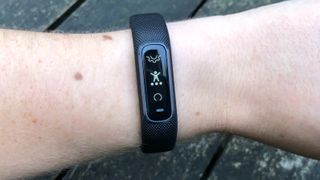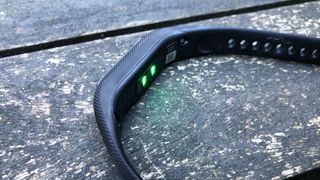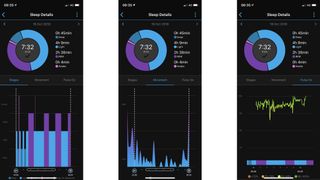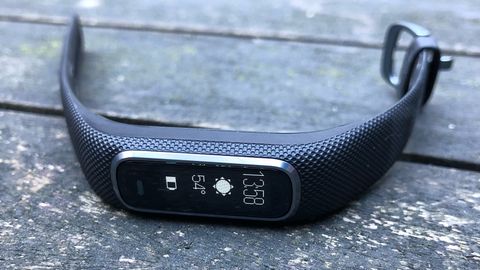Why you can trust TechRadar
Fitness
- Can track a whole range of activities
- Has a reasonable automatic tracking feature
- No GPS
The Garmin Vivosmart 4 can be worn as an everyday tracker, but the sensors inside are capable of keeping tabs on all kinds of things, including your fitness, lots of activities, your heart rate, all-day stress tracking, VO2 max and the Body Battery energy monitor.
There are a range of activities to choose from in the Vivosmart 4’s fitness menu, including walks, runs, strength training, yoga, pool swims and a few others.
At the very least, the device will time your exercise, but it will also collect more data depending on what you’re doing. So if you’re strength training, it will also track your exercises, reps and sets, along with your work and rest times.
In our testing we found the strength training feature mostly worked well, it missed a rep here and there, but it saves taking a notebook to the gym.

If you forget to start the timer, the Vivosmart 4 can automatically begin tracking some workouts, including swimming, walking, cycling and elliptical training.
It was exceptionally good at tracking walking and swimming, but registered elliptical training as walking once too, so although the automatic tracking does work, it won’t always be spot on.
If you’re an outdoor runner, hiker or cyclist you’ll be disappointed as there’s no on-board GPS. If you’re really dedicated to one of those activities, it might make more sense to shop around Garmin’s higher-end or more targeted trackers instead. This one is for casual users, it’s multi-purpose and it prefers to be indoors.

Heart rate
- Includes a VO2 max estimate and fitness age
- Heart rate data seems accurate
Fitness tracking is made much more detailed with the optical heart rate sensor. The device will keep tabs on your heart rate for all of the activities it times, and we found this to be very accurate. Unlike a lot of more affordable trackers that tend to lose heart rate data when it reaches top intensities, the Vivosmart 4 stayed consistent.
Of course if tracking heart rate is extremely important to your health or training, it might make sense to opt for a more high-end Garmin device, but for everyone else the HR tracking is very good.
But the heart rate sensor isn’t just useful for fitness. The Vivosmart 4 combines heart rate data with a VO2 max estimate to give you an idea of your fitness level and age.

This is likely to be pleasing for some (we're 31 and have the fitness of “an excellent 20-year-old", go us!) and a bit disappointing for others, but either way it’s a nice measurement to have the opportunity to change and improve over time.
You can also opt-in to have the device notify you if your heart rate unexpectedly rises above a certain threshold, which you can set. If you stay inactive for more than 10 minutes and your heart rate skyrockets above that threshold the whole time, you’ll be alerted.
Although this is a bit more simple in comparison to the Apple Watch 4’s latest heart rate features, it’s a big step in the right direction for giving consumers more visibility and insight into metrics you’d have had to visit a doctor to find out in the past.
Body Battery
- Handily tells you how worn down you are
- Doesn't give enough insight about what to do with your score
Body Battery is a proprietary metric from Garmin that’s essentially a measure of how wiped out you are each day. It uses data including your heart rate variability (HRV), sleep quality, stress levels and activity to figure out a number between 0 and 100.
The idea is if it’s dwindling you should take it easy, rest and do what you can to reduce stress. The higher it is the more you can push yourself, work out and generally be active and busy.
This is really handy for physical as well as mental health so you don’t burn out. It also works to show you patterns throughout your week, so you can see trends over time and maybe figure out why you have fluctuations in your energy levels.

It becomes fun to try and increase your battery, which can change throughout the day. It’s difficult to find the balance at first. The more you work out the better you’ll feel, but overdo it and that battery will drain. Sit down a lot and it might add back up, but won’t be contributing to it over time.
Although it’s a great addition, it would be good to get a few more specific tips and suggestions. Right now you need to go and look at what might be causing a low battery rather than the app offering up suggestions and actions to take next.
Sleep tracking
- Detailed, accurate sleep tracking
- Can track sleep stages, blood oxygen, VO2 max and SpO2
Thanks to the Vivosmart 4’s sensors, sleep tracking is accurate and highly detailed. It can monitor REM sleep and track blood oxygen saturation levels during the night with the Pulse Ox2 sensor.
Throughout a series of graphs it can differentiate between light, deep and REM stages of sleep, along with movement throughout the night.

The Vivosmart 4 has a pulse oximeter, which can keep tabs on your VO2 max, your SpO2 and your level of blood oxygenation. This is interesting, even if you’re not given much info about what it means. It’s probably much more valuable if you have a condition that requires that kind of tracking, such as sleep apnea.
Stress
- Can monitor your stress levels
- Includes a guided breathing exercise
The Garmin Vivosmart 4 uses your heart rate data to track your stress levels throughout the day and tells you whether your day has been calm, balanced or too stressed.
There’s also a ‘Relax Reminder’ feature, which you can turn on in the Garmin Connect app. This will send you an alert when your stress levels are elevated and ask if you want to take a moment to breathe. If you do it will give you a simple, guided breathing exercise.
As with all stress tracking tools, this worked wonders sometimes. Other times it made us stressed to realize we were stressed.
Current page: Fitness and tracking
Prev Page Introduction, price and design Next Page Battery life, interface and appBecca is a contributor to TechRadar, a freelance journalist and author. She’s been writing about consumer tech and popular science for more than ten years, covering all kinds of topics, including why robots have eyes and whether we’ll experience the overview effect one day. She’s particularly interested in VR/AR, wearables, digital health, space tech and chatting to experts and academics about the future. She’s contributed to TechRadar, T3, Wired, New Scientist, The Guardian, Inverse and many more. Her first book, Screen Time, came out in January 2021 with Bonnier Books. She loves science-fiction, brutalist architecture, and spending too much time floating through space in virtual reality.


